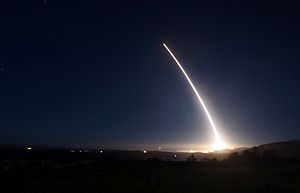This Thursday, the United States test-fired an unarmed Minuteman 3 intercontinental ballistic missile (ICBM) from a silo at Vandenberg Air Force Base in California to demonstrate its nuclear arms capacity, Reuters reports. The U.S. Airforce already launched an ICBM earlier in the week and has conducted at least 11 similar tests since the beginning of 2011.
The Minuteman missile was fired late Thursday night at 11:01 pm Pacific Standard Time and reached its target, the waters off the Kwajalein Atoll, located about 4,000 kilometers (2,500 miles) southwest of Honolulu in the Marshall Islands in the South Pacific , 30 minutes later.
Rather than a nuclear warhead, the ICBM missile carried various test instruments to evaluate the technical performance of the Cold War-era weapon system. During a 30-minute flight, in which it covered more than 6,500 kilometers (4,200 miles), the ICBM reached a top speed of 24,000 kilometers per hour (15,000 miles per hour).
The test of the ICBM was a clear message to strategic competitors such as Russia, China, and North Korea that the U.S. nuclear arms arsenal is operational and that it remains a functioning state instrument to deter aggression, according to U.S. Deputy Defense Secretary Robert Work, who witnessed the ICBM launch.
“That’s exactly why we do this,” Work said. “We and the Russians and the Chinese routinely do test shots to prove that the operational missiles that we have are reliable. And that is a signal … that we are prepared to use nuclear weapons in defense of our country if necessary.”
Talking about the LGM-30G Minuteman, Work said that “even though they’re old — they still remain the most effective, or one of the most effective, missiles in the world.” The Minuteman 3, first introduced in 1970, is the only land-based ICBM in service in the United States.
The current Minuteman 3 force consists of 450 missiles stationed in missile silos located in the U.S. states of Montana, North Dakota, and Wyoming. Each missile can carry up to three thermonuclear warheads with a 300 to 500 kilotons yield apiece.
The Pentagon is in the middle of initiating the modernization of its nuclear triad (land-based missiles, submarine-launched missiles, and long-range bombers) and plans to spend around $18 billion a year for 15 years starting in 2021 to modernize its nuclear weapons arsenal (See: “Should the US Spend $1 Trillion on Nuclear Weapons?”).
In fiscal year 2017, the Pentagon intends to commit $19 billion for nuclear modernization. However, “if it becomes clear that it’s too expensive, then it’s going to be up to our national leaders to debate,” Work told reporters present at the ICBM launch on Thursday night.

































